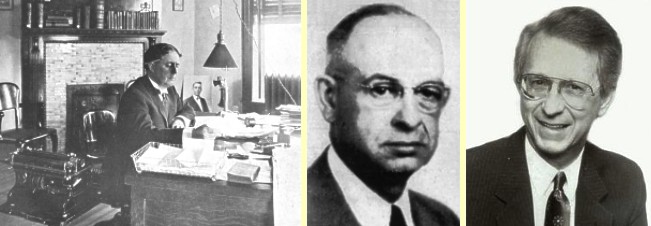
Left-to-right, department heads Charles J. Dillon, Edgar Talbert Keith and Deryl R. Leaming.
Kansas Snapshots by Gloria Freeland - April 2, 2010
Dry history?
It's hardly a secret that I'm a bit of a history junkie. And, of course, I'm interested in journalism. So with the centennial celebration of the journalism school coming up in the fall, it doesn't take much imagination to guess whose hand flew up, offering to pitch in.
But since I've also done event planning, advertising and a whole host of related things, I was quickly named the centennial coordinator. So in addition to the historical research, I became responsible for promoting the Sept. 2-4 event using postcards, posters, invitations, a Web site, audio and video messages and social media such as Twitter, Facebook and blogs. As they say, be careful what you wish for!
While I really enjoy the many aspects of the project, by far my favorite part is doing the historical research. One assignment I gave myself was to write biographies of the 15 people - 13 men and two women - who have served as administrators of the program.
As might be expected, most were either pretty accomplished in their field when they arrived or became so later. For example, the first - Charles James Dillon - was the editor of the Kansas City Star when he was hired away to teach "reportorial work" and to establish a Department of Industrial Journalism.
But there were some unexpected and somewhat entertaining discoveries about some of them, too. I was first drawn to Edgar Talbert Keith because I had trouble finding much about him. After searching through years of microfilm, I discovered he had served as interim department head three different times - twice in the 1930s and again in 1940. Perhaps it was that "interim" business that had won him such anonymity.
His obituary said he was recognized as one of the best typographers in the Midwest and one of the outstanding amateur photographers of the state. He took nearly all the sports pictures used in the Royal Purple yearbook and was one of the first Kansans to make full-color prints.
What really caught my attention, though, was that Keith had hand-lettered the names on the diplomas of nearly 17,000 graduates. An article in the May 21, 1930 Kansas Industrialist said,
"He is so expert at the art that frequently when the college print shop is 'shy' a letter or two in some odd font, Keith instructs the job to be printed with a blank space and he later puts in the missing letter by hand. It takes an experienced eye to detect the handmade letter, too."
The skill must have been in the genes for it was noted that his twin brother, E.B. Keith of the chemistry department was also an expert at lettering and he did the deed on the diplomas for the local high school.
Another surprise was Deryl R. Leaming. He was the department head just before I arrived at K-State, and served at several other schools, apparently with some distinction. He wrote three books, two of which - Academic Leadership: A Practical Guide to Chairing the Department and Managing People: A Guide for Department Chairs and Deans - are considered somewhat of a "must read" for people in those positions.
But Leaming was not nearly as dry as those titles sound. His obituary described him as "... a rather flamboyant personality, evidenced by his manner of dress." One former colleague remarked that James Bond had nothing on Leaming when it came to his clothing.
He apparently enjoyed a good joke, too. A friend remembered a running gag that whenever he and Leaming attended a Society of Professional Journalists convention, they'd eat someplace nice and they'd say it was Leaming's birthday.
At one of the conventions, they went to a South Pacific-themed restaurant.
"Out came shirtless guys beating drums, a belly dancer in a grass skirt and, I think, a flaming drink ...every head in this huge place turned toward Dr. Leaming. ... a shy person would have been mortified. Dr. Leaming was not a shy guy."
Another example of his sense of humor was the title of his memoir. The subtitle was, "Growing up in Rural Kansas. Remembering Days of Innocence." But the main title was, "A Once-Told Tale in Three-Part Harmony."
Who said history was dry?

Left-to-right, department heads Charles J. Dillon, Edgar Talbert Keith and Deryl R. Leaming.